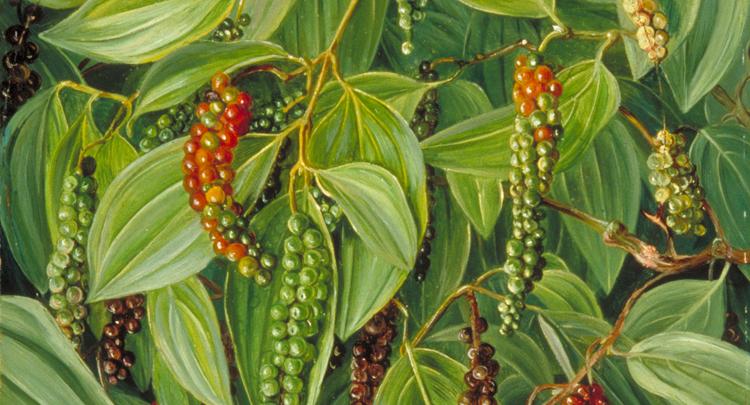India is home to a vast repertoire of diverse plants, with certain plants having significant economical and medicinal value. Evolving scientific advancements are bringing in novel methodologies for the examination of diverse herbal remedies which have a part of various cultural practices since ages.
Among them, the genus of Indian Piper along with its Crop Wild Relatives (CWRs) are garnering attention for their potential therapeutic applications offering promising avenues for medical research and drug development. The genus Piper, comprising pepper plants or pepper vines belongs to the family Piperaceae. Piper species are aromatic herbs that are used as culinary spices, and the secondary metabolites secreted by them have found use in various traditional medicine systems.
Several Piper species make up the Indian component of Piper and are primarily found in the tropical evergreen forests, with discontinuous distribution in the Eastern Ghats, the Western Ghats, and the Northeastern Himalayan region. Most of these plants prefer hot and humid conditions for their growth. The biodiversity hotspots of the Western Ghats are reported to be the sole existing source of wild P. nigrum germplasm across the globe.
Medicinal importance
Indian Piper CWRs have been traditionally used in various indigenous healing practices. The compounds found in these plants have demonstrated anti-inflammatory, antimicrobial, and antioxidant properties. Additionally, some species show potential for addressing digestive issues, respiratory ailments, and even neurological disorders. Piperine and piperlongumine are two of the most important constituents of Piper plants. It has been shown to have anti-cancer properties, along with having antiparasitic effects and anti-in?ammatory effects in the central nervous system. Several other extracts have been found have antimicrobial, anti-diabetic, anti-ulcer, diuretic and local anesthetic activities. Some Piper species with their traditional uses are mentioned below:
|
Piper species |
Therapeutic use
|
|
P. sylvaticum |
Treatment of bronchitis, diseases of the spleen, and tumors. Possess laxative, anthelmintic and carminative properties. Antidote for snake poison |
|
P. longum |
Antidote to snake bite and scorpion stings Treatment of chronic bronchitis, cough and cold and intestinal distress |
|
P. nigrum |
Treatment of intermittent fevers. Used to promote the secretion of bile. Recommended for neurological, broncho-pulmonary and gastrointestinal disorders, (including dyspepsia, ?atulence, constipation and hemorrhoids)
|
|
P. betle |
Anti-bacterial, digestive and pancreatic lipase stimulant, anti-?atulent agent. Used to cure wounds, urticaria, burns, impectigo, furuneloris, eczema, lymphangitis, asthma and rheumatism
|
|
P. retrofractum |
Stimulant, expectorant and carminative effects. Helps to improve digestion. Also used to treat intestinal disorders. Traditionally used to improve appetite and taste and to treat cough, cold, asthma, bronchitis, fever, piles and hemorrhoidal affections
|
|
P. sarmentosum |
Sanodyne, anti-in?ammatory, expectorant and carminative effects. Used to cure skin diseases, rheumatism, headache, diarrhoea and toothache
|
|
P. ribesioides |
Treatment of asthma, diarrhea, and abdominal pain, body wind element abnormality, alleviate chest congestion and excrete phlegm
|
|
P. wallichii |
Treatment of rheumatoid arthritis, in?ammatory diseases, cerebral infarction and angina
|
|
P. attenuatum |
Rubefacient, antioxidant, antitumor and diuretic activity |
|
P. mullesua |
Used to remove blood stasis, treat bleeding, bone fractures, injuries from falls, rheumatoid arthritis, rheumatic arthralgia, acroanesthesia, asthma, colds, stomach aches, abdominal pain, toothaches
|
|
P. miniatum |
Antibacterial activity |
|
P. pedicellatum |
Used to relive internal body pain, fever and cold. Possesses antifungal and antioxidant activity |
|
P. auritum |
Antiparasitic activity |
|
P. aduncum |
Used to treat cough, fever, rheumatism, influenza, stomachaches, and vaginitis |
|
P. thomsonii |
Treatment of gout and its roots can be used as diuretic |
|
P. ribesoides |
Antimicrobial activity |
|
P. colubrinum |
Anti-inflammatory, anti-oxidant and pain-relieving properties |
|
P. trichostachyon |
Used for treatment of colds, coughs, and fevers |
Research Opportunities
Despite their immense potential, Indian Piper CWRs face threats from habitat loss, climate change, and unsustainable harvesting. Conservation efforts are crucial to safeguarding these valuable genetic resources. Initiatives promoting sustainable harvesting practices, habitat protection, and ex-situ conservation can contribute to preserving the diversity of Indian Piper CWRs for future generations.
Exploring the therapeutic potential of Indian Piper CWRs opens up exciting research avenues. By tapping into the genetic diversity of these wild relatives, researchers may discover new leads for drug development, offering solutions to emerging health challenges. As we navigate the challenges of conservation and sustainable usage, the potential benefits derived from these diverse plant species underscore the importance of continued research. By unlocking the secrets of Indian Piper CWRs, we may pave the way for innovative and effective therapeutic interventions, bridging the gap between traditional wisdom and modern medicine.
References
Biswas P, Ghorai M, Mishra T, Gopalakrishnan AV, et al. (2022) Piper longum L.: A comprehensive review on traditional uses, phytochemistry, pharmacology, and health-promoting activities. Phytotherapy Research: 36(12): 4425–4476
Chanchal C, Thongam B, Handique PJ (2015) Morphological diversity and characterization of some of the wild Piper species of North East India. Genetic Resources and Crop Evolution 62: 303–313
Salehi B, Zakaria ZA, Gyawali R, et al. (2019) Piper Species: A comprehensive review on their phytochemistry, biological activities and applications. Molecules 24(7): 1364
Sen S, Dayanandan S, Davis T, Ganesan R, Jagadish MR, Mathew PJ, Ravikanth G (2019) Origin and evolution of the genus Piper in Peninsular India. Molecular Phylogenetics and Evolution 138: 102-113
